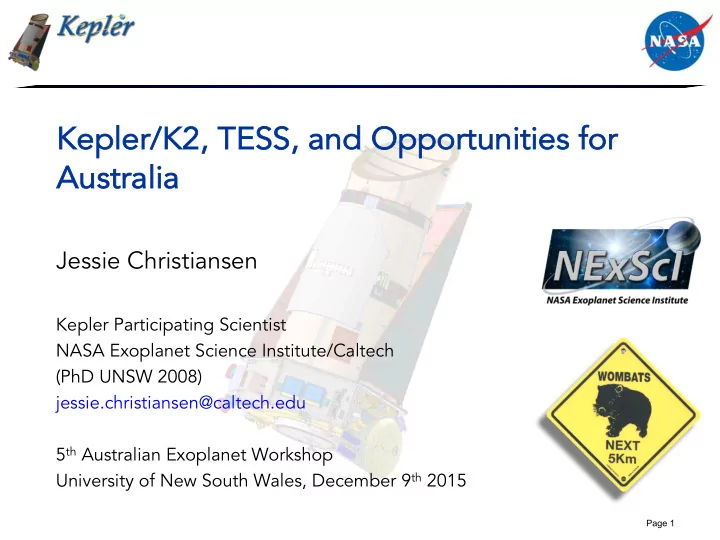

Kepler/ r/K2, TESS, and Opportu rtuniti ties for r Austra tralia Jessie Christiansen Kepler Participating Scientist NASA Exoplanet Science Institute/Caltech (PhD UNSW 2008) jessie.christiansen@caltech.edu 5 th Australian Exoplanet Workshop University of New South Wales, December 9 th 2015 Page 1
NASA’s Search for Extrasolar Planets “Discover how the universe works, explore how it began and evolved, and search for life on planets around other stars.” Credit: nasa.gov Page 2
Designing Kepler Kepler was optimized to measure η Earth ; for finding terrestrial planets (0.5 to o 10 Earth masses) in the habitable zone (out to 1 AU) of stars like the Sun Continuously, simultaneously monitored nearly 200,000 stars, 1m Schmidt o telescope, 30min integrations, field-of-view of >100 sq deg with 42 CCDs Photometric precision of 20 ppm in 6.5 hours on Vmag = 12 solar-like star o Bandpass is 4300 - 8900 Å, plate scale is 3.98 ” /pixel o Page 3
The Transit Method Mercury (0.002%) ` Earth (0.01%) Jupiter (1%) 4 Page 4
Transiting Planets • Transiting planets are extremely informative – You can obtain bulk properties – radius, mass, density – You can measure atmospheric properties – emission, absorption • But! Not every star with planets will show transits – Requires a geometric alignment that goes as Rp/a = 0.5% for Earth at 1AU ~1% relative drop • Therefore, in a discovery survey, need to observe many stars – Go narrow/deep (Kepler) – Go wide/shallow (TESS, Plato) Page 5
The story so far… Page 6
Determining η Earth We need to calculate both: N measured : the number of real Earth-like η EARTH = N measured , where planets in the Kepler sample (i.e. N measurable detectable understanding the reliability, or false positive rate) N detectable : the number of stars around which the Kepler pipeline would ∑ N measurable = P i , geo P have detected such planets (i.e. i , SNR detectable understanding the completeness) i Probability of ith Geometric (The aim of my research has been to planet to having probability of ith characterise P i,SNR for the Kepler strength SNR being planet to transit detected pipeline, which we can then use to calculate the pipeline detection efficiency (Christiansen+2013,2015) Page 7
Current planet candidates • There IS a Q1-Q17 catalogue (full Kepler observing baseline – Coughlin+2015), but there was a processing issue and we are not recommending people use that catalogue for occurrence rate calculations • Q1-Q16 catalogue (Mullally+2015): Page 8
Current occurrence rate estimates • Using the method described by Youdin 2011; Burke, Christiansen et al. (2015) – parametric occurrence rate (best fit = broken power law in radius and power law in period) • 50-200 days, 1-2Re planets, using Q1-Q16 catalogue (Mullally et al. 2015): 2.5σ 3σ Page 9
What’s next for Kepler? • Second (of four) reactions wheels failed in 2013 – no more precision pointing at the original Kepler field è K2! • Slightly more than four years of data in total • Final version of the pipeline (re)running now (or just finished early this week!) • Full TCE list expected at the NASA Exoplanet Archive early next year • Including fully automated dispositions (planet candidate, false positive – no more humans making decisions!) and fully characterised detection efficiency • We hope and expect the community to continue to produce many excellent analyses using the available data (pixels, light curves, TCE and planet candidate catalogues, completeness and reliability products) Page 10
K2: Extending Kepler’s Power to the Ecliptic • Gave the Ball engineers a challenge – what to do with two reaction wheels? • Their response? Extremely high precision photometry (on par with original Kepler)! • But… for 75 days at a time. • K2 (unlike Kepler) is entirely guest-observer driven -no reserved science • ‘Campaigns’ – fields around the ecliptic, ~75 days long, ~4 per year • 10-20K long cadence (30min) targets, 50-100 short cadence (1min) targets Page 11
K2: Extending Kepler’s Power to the Ecliptic Proposal cycle, every six months – up to cycle 4 (C11, C12, C13) • Two-step process: • St Step ep 1 d 1 dea eadline: Feb ne: Feb 5, 2016 5, 2016 • St Step ep 2 d 2 dea eadline: M ne: Mar 4, 2016 4, 2016 • C11 start date: Sep 24, 2016 • No proprietary period! Pixels and aperture photometry light curves available • There is money! (But only if you have a US affiliation…) • Page 12
K2: Extending Kepler’s Power to the Ecliptic Exoplanet results • coming in incredibly quickly – wild west of space-based precision photometry! Exploring exoplanet • population variances – stellar type, Galactic latitude, … (Other areas of • transient astronomy: white dwarfs, flares, asteroseismology, …) Page 13
TESS – Transiting Exoplanet Survey Satellite Four 10cm telescopes, each with 24x24deg field of view • 600-1000nm bandpass (enough different from Kepler for interesting • degeneracy-breaking!) Eccentric high Earth orbit – 17-59 Earth radii • Two year mission – one year northern sky, one year southern sky • Page 14
TESS – Transiting Exoplanet Survey Satellite 200,000 stars, 1-minute cadence (!!!) – postage stamps around targets, not all • pixels come down Main sequence dwarfs (FGKM) 4-12 th magnitude • Full frame images every 30 minutes (!!!) • Page 15
TESS – Transiting Exoplanet Survey Satellite Prime mission goal to measure masses of 50 nearby planets – some funded • follow-up – focus on Earths and super-Earths The real goal is to find the best targets for the next 100+ years of characterisation • with Hubble, JWST, etc No proprietary period (!!!) • TESS Guest Investigator • Program – still taking shape, but something like 25,000 targets reserved for guest proposals One round of proposals • (maybe two), a year before launch (next year!) Taking feedback now… • Page 16
Recommend
More recommend